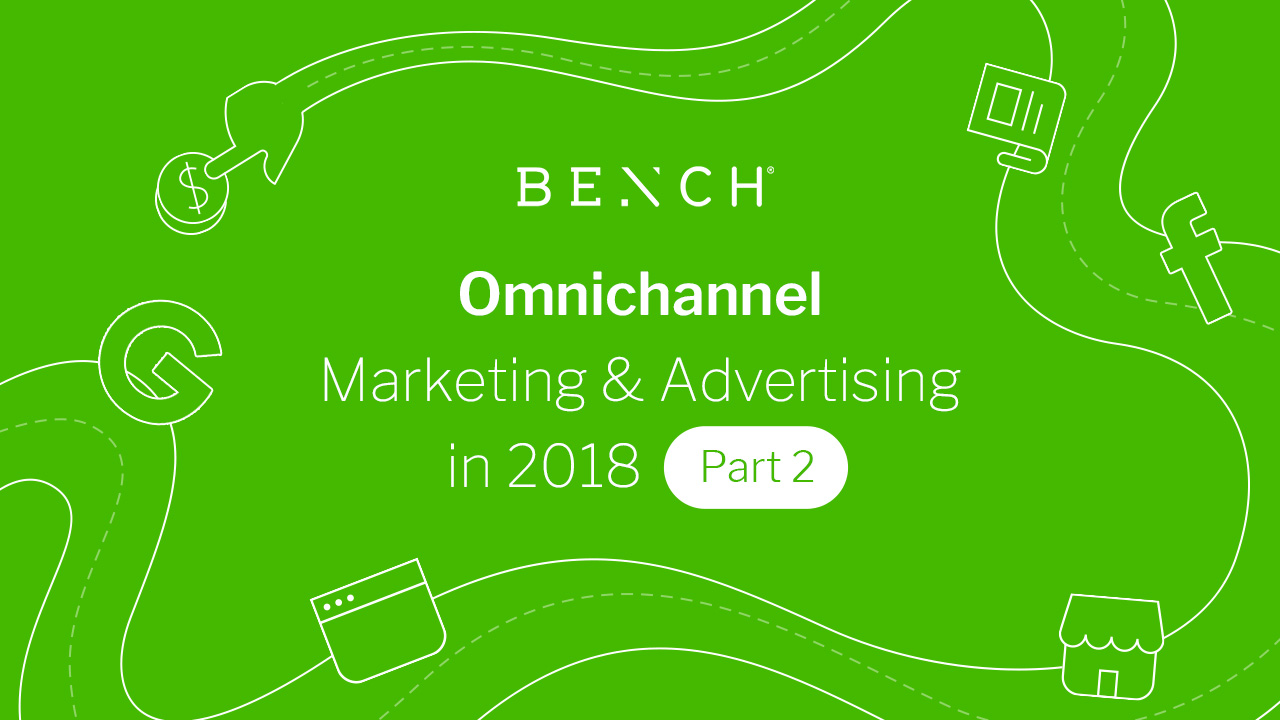This blog is the second in our series that examines omnichannel marketing and advertising through the lense of the Bench framework in order to support the entire customer journey.
- In this second part, we look at how to use advertising to support an omnichannel marketing strategy
- Part 3 explains the Bench audience mapping methodology.
In part one of this blog series, we contrasted multi-channel and omnichannel marketing and presented the Bench ‘mindset planning’ approach for creating an integrated marketing and media strategy.
While omnichannel marketing is focused on the customer experience, you first have to reach those customers in order to provide them with any sort of experience.
At the end of the day, as important as CX is, it’s of no use if your target market is only vaguely aware of your product or solution. For most marketers, digital advertising is the quickest method of getting users into the purchase funnel.
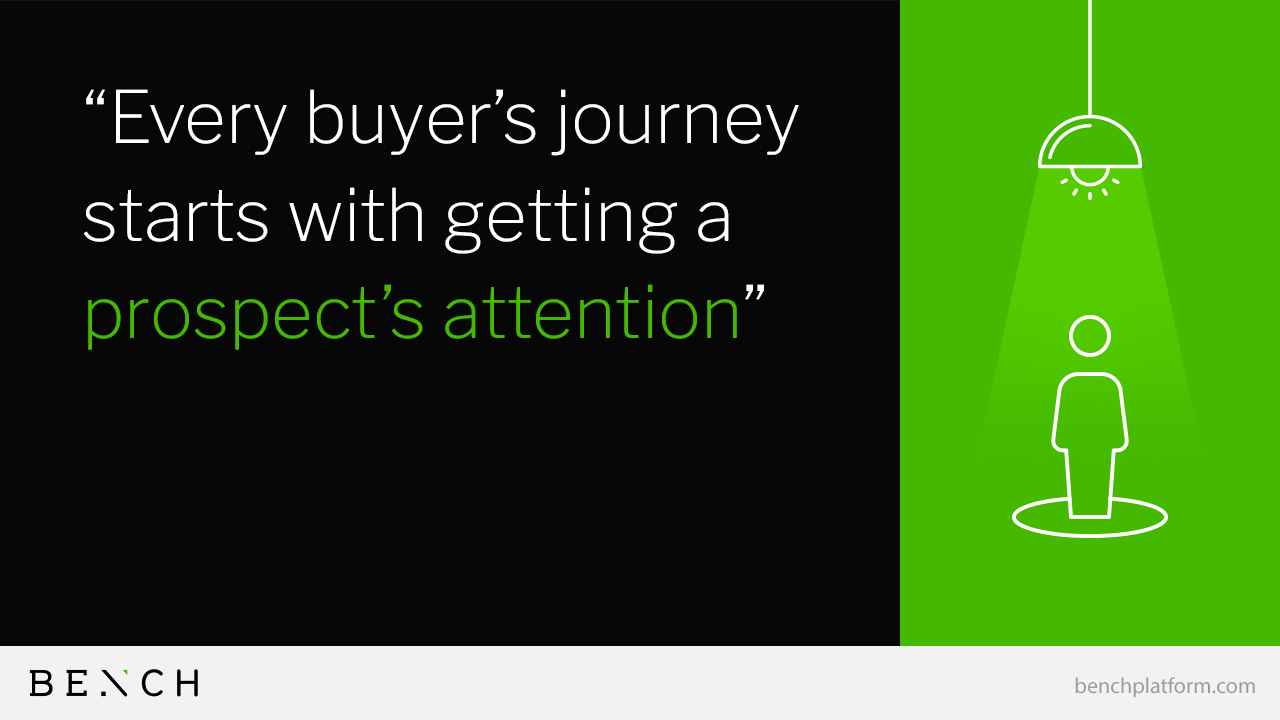
In this blog, we will:
- Explore how advertising fits into the omnichannel marketing mix
- Expand on how the Bench campaign framework can help you structure your media operations in a way that supports your marketing objectives at each stage of the buyer journey.
Giving Full Funnel Advertising the Full Throttle
The problem is that it’s very difficult to run an efficient, omnichannel advertising strategy given the amount of work that goes into optimizing and tracking even a single channel.
As a result, marketers tend to default to using the one or two channels that have historically been known to produce results.
But as good as Facebook is as an advertising platform, it doesn’t cater to all of your brand’s digital touchpoints with your customer.
And, sure, you may throw a bit of remarketing into the mix or add a pinch of native advertising to the equation. Yet these are isolated tactics that aren’t backed by a robust underlying framework that ties advertising activities to strategic marketing outcomes.
However, the fragmentation of media and the plethora of available advertising options make having such a framework a strategic imperative for marketing:
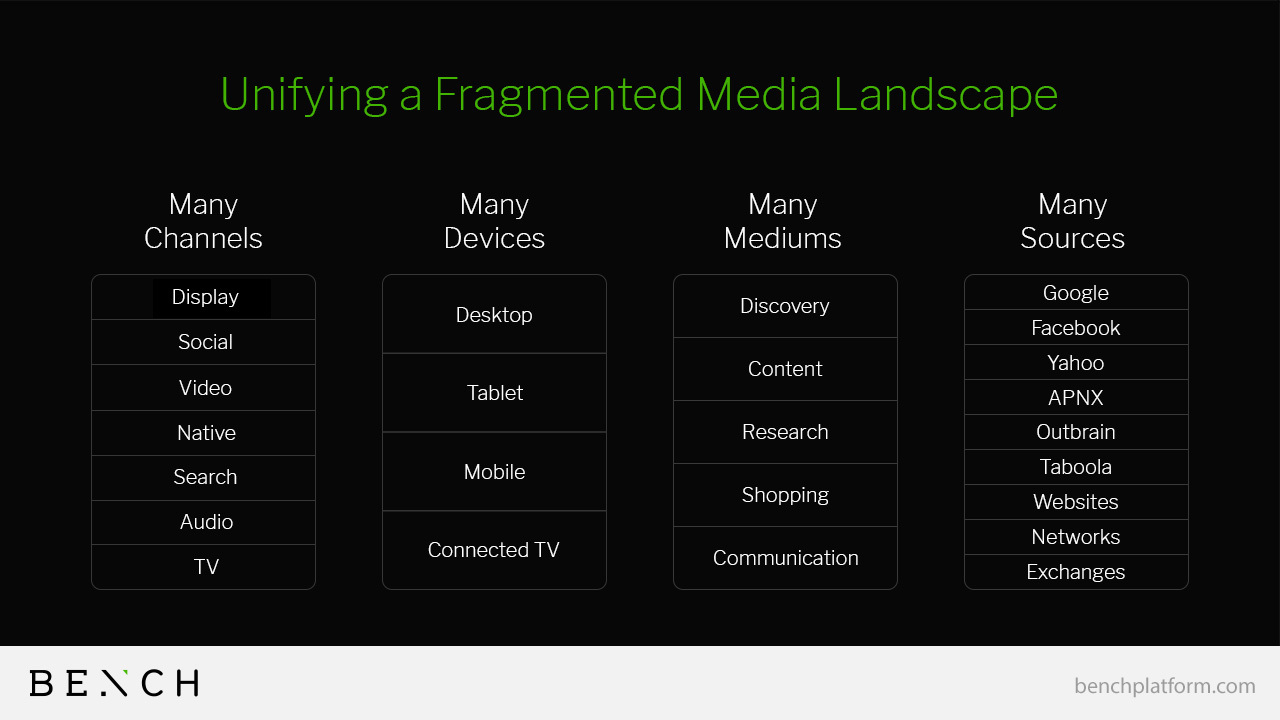
This scenario is further complicated by the fact that publishers’ and ad platforms’ interests diverge from those of your brand:
Every player in the media ecosystem wants the bulk of your ad spend, which gives them incentive to try and sell you on a solution that is inherently not omnichannel, and that ties you to that particular publisher or platform for good or ill.
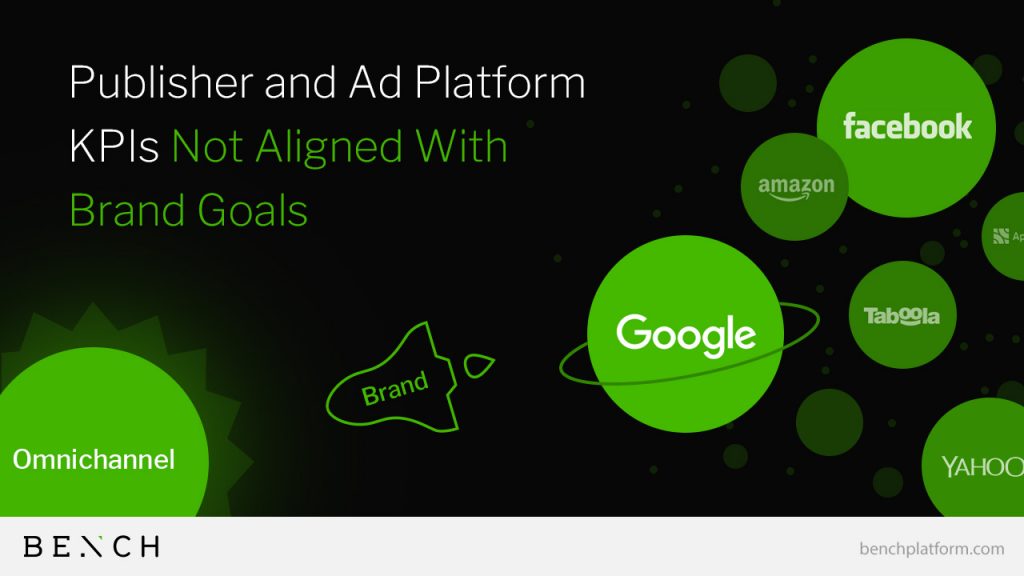
But it’s an omnichannel world out there! And there are just too many downsides to focusing on just one or two channels:
- Low “share of voice” at each of your audiences’ daily brand touchpoints
- Each channel often serves only a particular objective but rarely all of them
- Siloed channels have separate audience groups, targeting options and ad formats that may not 100% align with your marketing strategy
- Different tools and technology are required in order to maximize results on each platform
- As a result of the above, there’s often limited ability to meet particular marketing goals.
Now, let’s see how your advertising can extend across the full funnel.
Advertising Gets a Seat at the Omnichannel Table
Usually, other tactics and methods, such as email or content marketing, are seen as the best way to move the buyer journey forward and advertising gets given the task of awareness-building.
It is a strategic mistake to pigeonhole advertising as it can, and should, act as a complementary tactic at each stage of the buying funnel. As long as it used in an integrated way in tandem with other marketing activity.
Only by tightly coupling content marketing or inbound marketing with advertising, can a true omnichannel presence be gained by your brand.
Another issue that hinders digital advertising results is that the measurement of outcomes is often based on vanity metrics such as impressions or CPM.
A measurement methodology based on such loose metrics, while common, not only wastes your media budget but often significantly hurts marketing results.
The Bench campaign framework was created to help advertisers go beyond simplistic measures of success and provide accountability even when driving awareness or engagement.
The framework provides a robust and reliable method for structuring omnichannel ad campaigns. To date, it has helped hundreds of advertisers, including leading multinational brands, achieve results globally.
Here’s an example of what a full-funnel advertising strategy looks like – together with associated KPIs for each funnel stage:
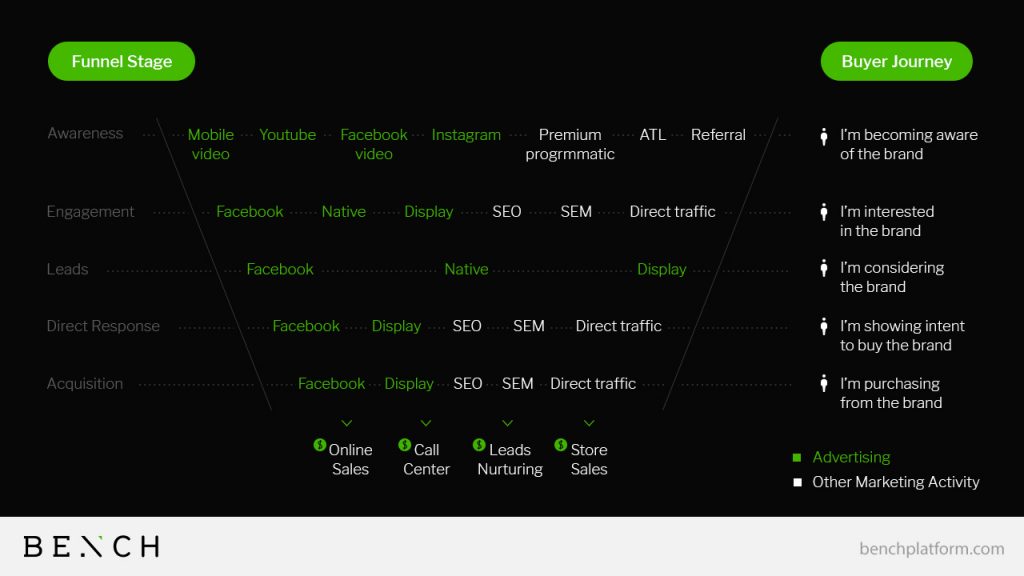
The Post-Channel Marketing Era
As mentioned in the first blog part of this series, the Bench framework hinges not on planning around specific channels or media platforms but based on your audience’s mindset and their entire buyer journey.
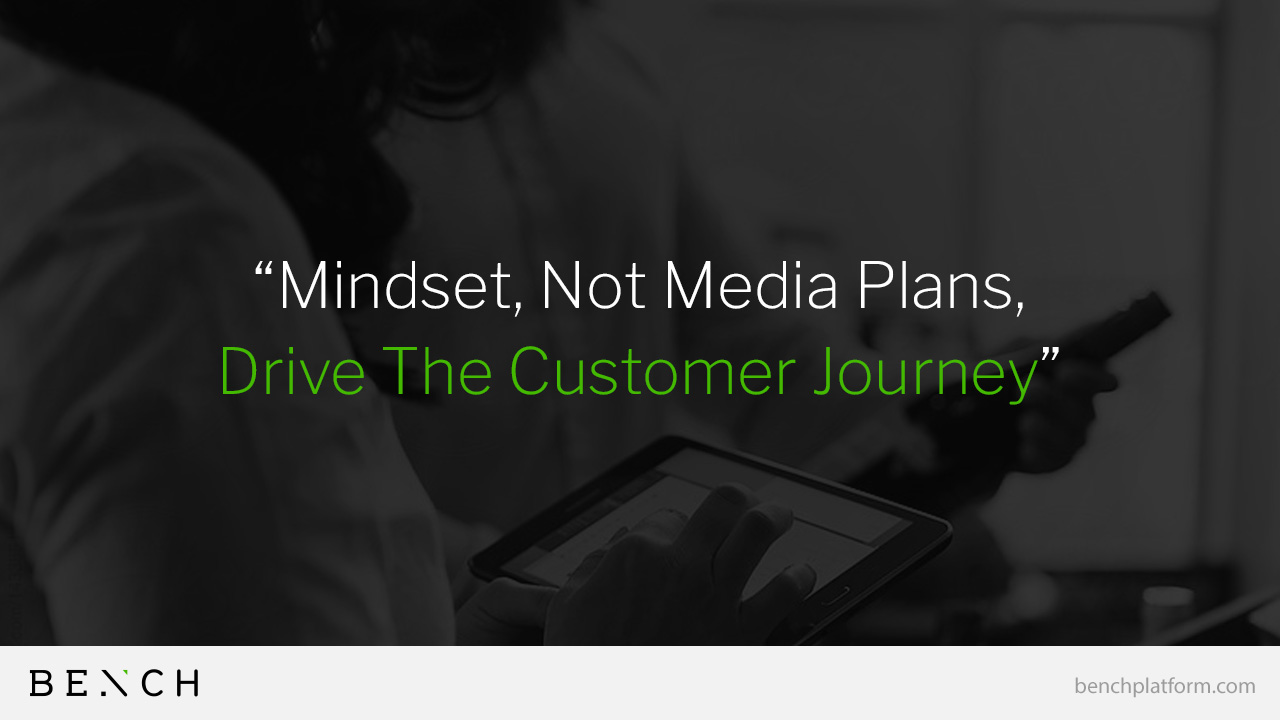
It’s time marketers moved into a “post-channel” world where the audiences and messages become the primary concern rather than the specific medium / platform / channel that is used for their dissemination.
Specifically, the Bench framework revolves around setting audience-first “goals” for each stage of the funnel, which correlate closely to tangible business results. And while McLuhan’s famous adage – “the medium is the message” – still holds true to a certain extent, using a post-channel approach, you’re not constrained by the medium.
Moving to this way of running advertising campaigns brings many benefits, including:
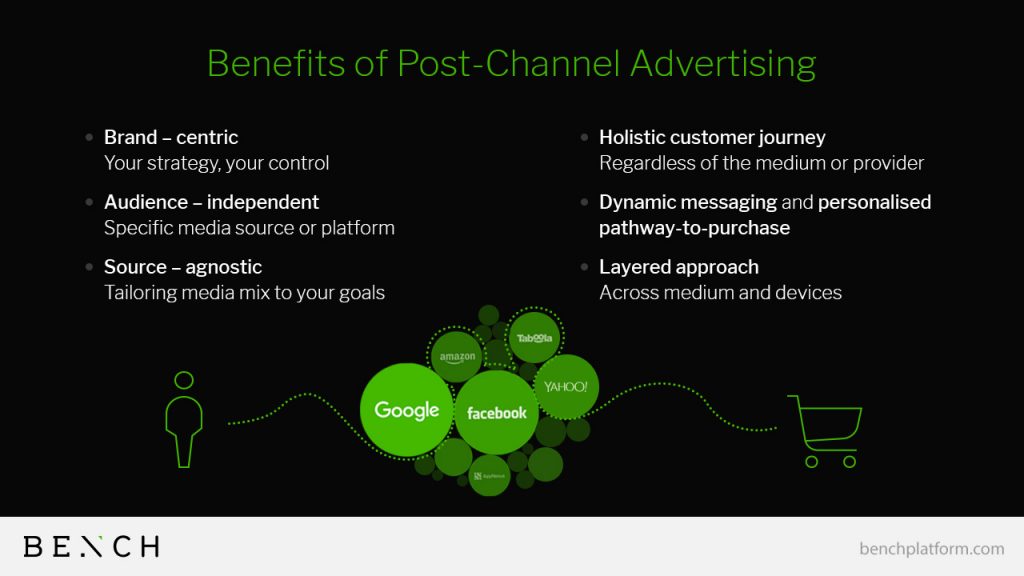
Rather than letting each platform and channel control your objectives through the metrics they impose on you, you start to use your audiences as the measuring stick and structure your campaigns around that.
The Bench Campaign Framework
The Bench framework for running media campaigns is based on a hierarchy that, when implemented, allows for an agile and lean approach that continuously improves your results-based metric(s) of choice.
The framework was specifically tailored to work for omnichannel advertising and involves structuring campaigns as follows:
- Advertiser
- Campaign
- Layer
- Channel
- Source
- Promo
- Message
- Ad

As a result of continuously using the framework and having appropriate systems in place to track and analyze historical data, advertisers start to build up a knowledge store of how certain campaigns perform across all channels.
Using the Bench framework helps to avoid the usual campaign planning “groundhog day” that most marketing teams re-live come the start of a new month, quarter or year.
As a result, your marketing becomes more efficient and effective with each new campaign that you launch. Each campaign is now built on a bank of knowledge you’ve created, which informs all future media investment decisions.
Here’s an example of how an omnichannel advertising campaign would be structured for a health insurance company:
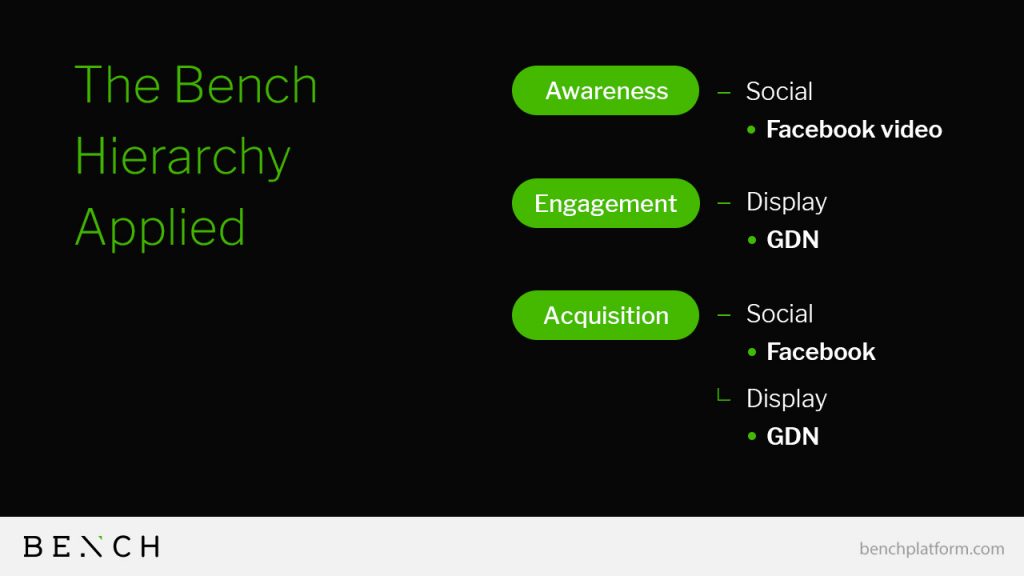
The Advertising Layer Cake
The Bench funnel takes the concept of the traditional marketing funnel as a foundation and tailors it to work for omnichannel advertising. The specific Bench ‘layers’ – or funnel stages – are:
- Awareness
- Engagement
- Leads
- Direct response
- Acquisition.
At each ‘layer,’ a number of channels and audience strategies can co-exist depending on the marketing objectives. A campaign will usually have a few active layers that, taken together, allow for true, omnichannel throughout across the buyer journey.
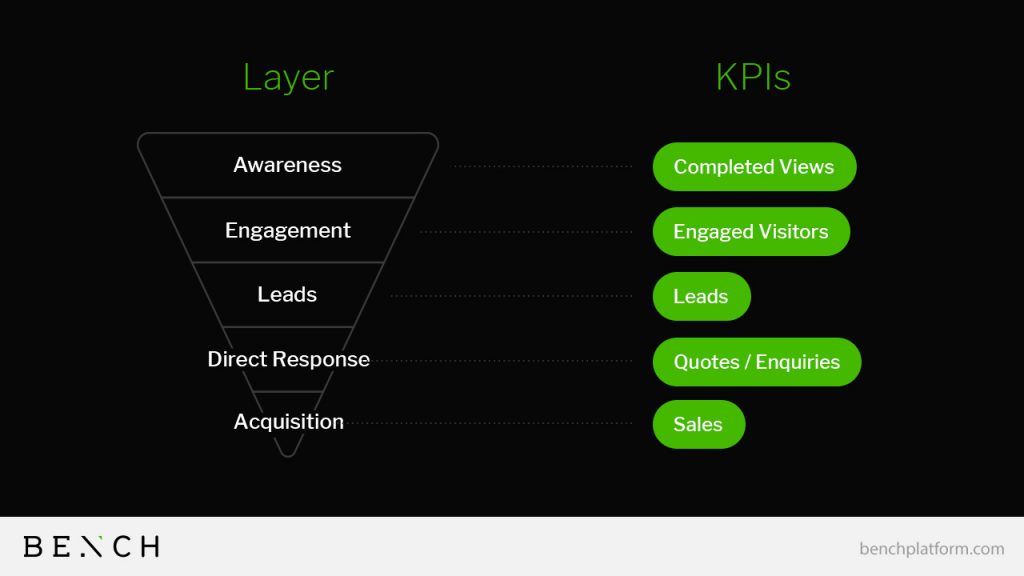
It’s important to point out that each layer can have different ‘goals’ that need to be achieved as part of an omnichannel marketing strategy. An example of such goals can include:
- Cost per view / completed view (Video)
- Cost per engaged visitor
- Cost per lead / sale
- Cost per registration / quote / inquiry
- Cost per acquisition.
It is critical to note that the ads and messages you create need to match the mindset of your prospect at each layer.
Advertising Made Scientific
Used in tandem, the Bench mindset planning approach and media campaign framework make your marketing more agile and scientific.
Embracing this way omnichannel advertising methodology will help your marketing team quickly iterate and try different messages, which is the foundation of real-time and lean marketing.
The Bench omnichannel advertising platform was built around this framework and lets you bring all of your digital media under one roof. The platform adds the necessary technical and operational muscle so you can start achieving results with omnichannel advertising today.
Want to learn more? See what a variety of brands achieved using the Bench framework. Or alternatively, book a demo to see the platform in action.
